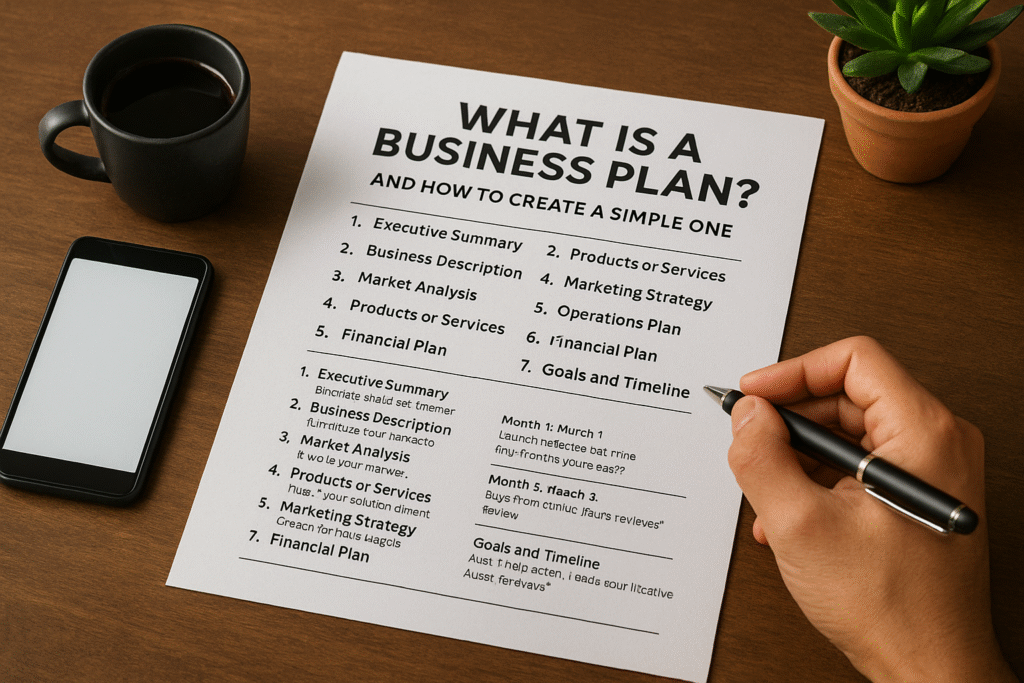Many aspiring entrepreneurs get intimidated by the idea of a business plan. They imagine long, complex documents filled with financial jargon and charts. But a business plan doesn’t need to be overwhelming. In fact, a simple, well-organized plan is often more useful—especially for small business owners and solo entrepreneurs.
This article explains what a business plan really is, why it matters, and how you can create a basic one today.
What Is a Business Plan?
A business plan is a written document that outlines the goals of your business and how you plan to achieve them. It acts as a roadmap, showing where you’re going and how you’ll get there.
Think of it as your business GPS—it helps you stay on track, even when you hit unexpected detours.
Why Do You Need a Business Plan?
Even if you’re not seeking investors or loans, having a plan helps you:
- Clarify your goals
- Stay focused and organized
- Make better decisions
- Track your progress
- Avoid wasting time and money
Plus, if you ever do seek funding or partnerships, a business plan shows that you’re serious and prepared.
The 7 Key Sections of a Simple Business Plan
You don’t need 30 pages. Here’s what a simple plan can include:
1. Executive Summary
This is a quick overview of your business. Include:
- What your business does
- Who you serve
- What problem you solve
- Your business goals
Keep it to a few short paragraphs.
2. Business Description
Go a bit deeper here. Describe:
- The mission and vision of your business
- Your story—why you started
- What makes your business unique
This section helps connect emotionally with partners or investors.
3. Market Analysis
Prove that you’ve done your research:
- Who is your target audience?
- What problems do they face?
- What competitors already exist?
- How is your solution different?
You don’t need a marketing degree—just thoughtful answers based on research.
4. Products or Services
Clearly explain:
- What you’re selling
- Key features and benefits
- How it helps your customer
- Your pricing model
Use clear, simple language so anyone can understand.
5. Marketing Strategy
Share how you plan to reach your audience:
- Online marketing (social media, email, ads)
- Word of mouth
- Referrals or partnerships
- In-person promotion
Also include how you’ll build trust, like through testimonials or content.
6. Operations Plan
This is about how your business runs day to day:
- Where do you work from?
- What tools or systems do you use?
- Who handles what tasks? (even if it’s just you)
- How do you handle orders, communication, and customer service?
7. Financial Plan
Don’t skip this part—even if it’s basic. Include:
- How much you need to start
- What your monthly costs will be
- Revenue projections
- Break-even point (how much you need to earn to cover costs)
Use a spreadsheet or simple budget template to back this up.
Bonus: Your Goals and Timeline
End with a list of goals and when you hope to reach them. For example:
- Month 1: Launch website and get 10 subscribers
- Month 3: Make your first $1,000
- Month 6: Reach 100 customers and $5,000 in revenue
Tracking your goals gives you motivation and focus.
Common Mistakes to Avoid
- Making it too long (keep it simple)
- Using complex language (write like you speak)
- Guessing numbers without research
- Forgetting to update the plan regularly
- Writing it once and never using it again
Final Thought: A Business Plan is Your Success Map
A simple business plan won’t guarantee success—but it gives you direction, helps you stay on track, and shows others that you’re serious. You don’t need to be a professional writer to create one. Start with what you know, and build as you grow.
Your dream deserves a plan. Start writing yours today.

